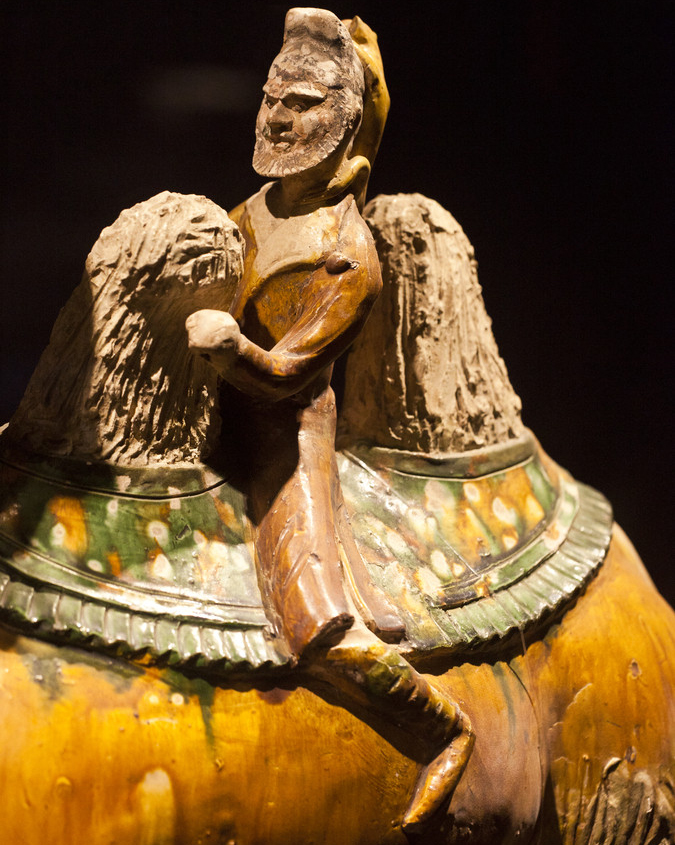Tang writers gave vivid physical descriptions of Hu minority

Tangsancai, a type of tri-coloured glazed pottery from the Tang Dynasty, has a clear and vivid depiction of the Hu peoples.
In the central plains of ancient China, the terms "Hu" and "Hu peoples" were usually used to refer to the Xiongnu and other northern and western barbarian tribes. On account of their different ethnicity, Han people in the Central Plain had already begun to take note of the Hu peoples' appearances before the Tang Dynasty (618-907). Chen Yinque (1890-1969), a distinguished historian, litterateur of classics, linguist and poet, said that Tang historical materials described the ancient Hu peoples' appearance as being characterized by high-bridged noses, deep eyes and heavy beards.
Though Hu peoples were often depicted by Tang poets as members of the northern and western Chinese ethnic groups—the Xiongnu, Turks, Uygur, Xianbei and the Tibetan Tubo—the term also referred to people from Ferghana Valley in Central Asia, the oasis city of Gaochang in the Taklamakan Desert, Persia and Tianzhu, a part of modern-day India. It included people from the Western Region, which comprises modern-day Xinjiang and parts of Central Asia, as well. People in the Tang Dynasty had great curiosity about the Hu peoples. In the early Tang Dynasty, Confucian scholar and historian Yan Shigu (581-645) wrote in the Book of Han: "The appearance of the Wusun people (originally from the Qilian Mountains and Dunhuang) was the strangest in the Western Regions. Today, the Hu peoples' green eyes and red beards originate from the Wusun.”
In the eyes of Han people, the appearance of the Hu peoples is characterized as follows:
First, there are the beards. In contrast to the Han peoples' black beards, the Hu peoples' beards are both red and bushy. In the eyes of people in the Central Plain, the Hu peoples' red beards possessed a beautiful color. Wang Guowei (1877-1927), a well-known Chinese scholar, once elaborated by saying: "Chinese who look like the Hu people were called 'Hu' or 'Huzi,' which literally means 'beards.' This name was applied to the Hu people during the Six Dynasties (222-589). In the Tang Dynasty, people who looked like the Hu peoples were also called 'Huzi'.”
Second, there are the eyes. The Hu peoples' eyes are described as looking like emerald, which piqued the curiousity of people in the Central Plain at the time. The famous Tang poet Du Fu (712-770) compared the eagle's green and deep eyes to those of the Hu people, in the poem "Drawing Eagle. "
Third, there are the noses. The Hu peoples' noses can be distinguished from those of the Han people. Their bridges are very high and the tips are pointed. The Tang poet Fan Shu (?-c. 877) published the poem "Presenting a Poem to a Hu Girl at the Feast in Guizhou" by Lu Yanmeng in Yunxi Miscellanea. In the poem, Lu described the Hu girl's eyes as deep as the water of the Xiang River and her nose as high as the Hua Mountain. Although Lu's poem exaggerated the Hu girl's appearance, it completely represented the Han people's curiosity about the Hu peoples.
French Sinologist Jacques Gernet (1921- ) indicated in A History of Chinese Civilization that the Tang writers' extreme exaggerations and abundant imagination tend to contain an ironic meaning and a level of mockery but preserve a vivid ethnic memory.
In addition to the Hu peoples' appearance, Tang writers left rich descriptions of their languages. The lack of understanding about Hu peoples' language inspired the Tang writers' imaginations. They even likened Hu peoples' language to the pipa, a clear and melodious plucked instrument, adding some literary and romantic color to descriptions of their language.
Gao Jianxin and Cui Yun are from Inner Mongolia University.
